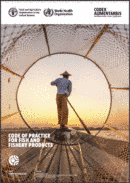Regulatory Environment for Mortality Due to Grow Out
Regulatory framework interventions support the implementation of best practices which help prevent mortality during grow out.
Biosecurity
Biosecurity
Biosecurity describes the systems put in place to protect a fish farm from diseases. These systems reduce the risk of damaging diseases entering a farm, can prevent health issues emerging within the farm, and can reduce impacts of disease when it occurs.
The purpose of an aquaculture biosecurity plan is to:
- Reduce the risk of diseases being introduced into your farm (entry-level biosecurity)
- Reduce the risk of diseases spreading within your farm (internal biosecurity)
- Reduce the risk of diseases escaping from your farm (exit-level biosecurity)
- Have emergency response protocols in place for serious disease outbreaks (all three levels of biosecurity)
Best Practices and Disease Prevention
Best Practices and Disease Prevention
According to a World Bank report which presented a review of case study findings, there are several key structural and behavioural attributes of the aquaculture industry that make it vulnerable to disease. It is also clear that, while the species, production systems, and names of the participants and institutions involved in the operation and regulation of aquaculture vary from place to place, the science and logic that can reduce the incidence and severity of disease are common throughout the industry.
As aquaculture continues to grow, a new regulatory framework is needed. Important issues to address include:
Mechanisms to avoid over concentration of farming activity in any given area.
Improved pathogen dispersion control strategies.
Boundary definition of production zones.
Definition of zone carrying capacity.
Surveillance programs to detect and/or predict new environmental and disease issues before they can affect the entire industry.
Regulatory in Action: Australia’s National Strategic Plan for Aquatic Animal Health
Regulatory in Action: Australia’s National Strategic Plan for Aquatic Animal Health
AQUAPLAN is Australia’s National Strategic Plan for Aquatic Animal Health. The plan outlines objectives and priorities to enhance Australia’s management of aquatic animal health. AQUAPLAN is a collaborative initiative that is developed and implemented by the Australian and state and territory governments and aquatic animal industries.
The Department of Agriculture (the department) coordinates the development and implementation of AQUAPLAN. National implementation of AQUAPLAN activities and projects is overseen by the Animal Health Committee (AHC) and its Sub-Committee on Aquatic Animal Health (SCAAH) in close collaboration with industry. Australia has had two previous five-year AQUAPLANs. AQUAPLAN 2014–2019 is Australia’s current national strategic plan for aquatic animal health.
Regulatory in Action: UK authorisation conditions for aquaculture production businesses
Regulatory in Action: UK authorisation conditions for aquaculture production businesses
Establishing an aquaculture farm requires authorisation. In the UK, a fish health inspector (FHI) will outline the conditions of authorisation. In order to successfully obtain a licence to establish a farm, the business owner must keep records of all movements of fish, follow good hygiene practice, comply with surveillance requirements requested by a FHI and comply with procedures in an approved biosecurity management plan. Authorisation is granted when it is seen that the operation of the business will not lead to an unacceptable risk of spreading disease.
Furthermore, businesses must keep a record of:
- the movement of any aquaculture animal or any aquaculture animal product into or out of the premises of the business
- the number of any aquaculture animals that have died in each epidemiological unit within the premises
- the results of any surveillance carried out by the business
- the results of any surveillance carried out by the competent authority which have been notified to the business
Aquaculture businesses in the UK have access to a Regulatory Toolbox which helps them navigate the various legal obligations and requirements.
Key Publications
Aquaculture Farm Biosecurity Plan generic guidelines and template This guides the development of biosecurity plans for application at the farm level, and is meant to be adapted for specific sectors (e.g. prawn or abalone farming) and production systems (e.g. pond or recirculation). | |
Aquaculture Regulatory Toolbox for England Aquaculture regulatory issues portal to assist businesses and regulators deal with aquaculture applications. | |
Reducing Disease Risk In Aquaculture This report is the result of an international effort to bring together, synthesize, analyse and draw practical lessons from the experience of major aquaculture disease outbreaks in Chile, Vietnam, Madagascar, and Mozambique. |
More Resources
More Resources
31 October 2023














